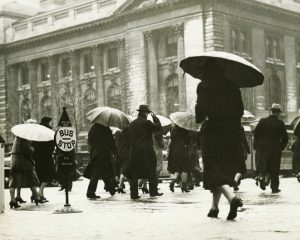Why Ray Dalio Thinks We’re in the 1930s
The comments below are an edited and abridged synopsis of an article by GuruFocus.com
Ray Dalio, founder of Bridgewater Associates, thinks we’ve regressed to the late 1930s. In recent interviews, he described three similarities between today and the decade that brought us the Great Depression. According to Dalio, if the economy begins to slow, these similarities may produce serious problems.

Pedestrians walking in rain in New York City, (B&W) (Pedestrians walking in rain in New York City,
This first similarity Dalio identified deals with is monetary policy. He argued that central banks can’t rely on monetary policy forever. Eventually, the benefits of monetary policy diminish. Cutting rates or expanding the Fed’s portfolio, for example, won’t boost the economy if debt levels are too high. Dalio thinks we may have reached that point. And while many politicians, economists and investors are banking on more stimulus, the effects shouldn’t be counted on.
Concerns over monetary policy are also making other gurus cautious. Seth Klarman (Trades, Portfolio) highlighted in his annual letter to investors the upcoming troubles with government intervention, rising deficits and sovereign debt levels. He also thinks poor fiscal and monetary policy could eventually spell the end for the US dollar as the world’s reserve currency.
Dalio pointed to increasing wealth inequality as a danger to the status quo. He argued that the polarization of politics is particularly concerning. He is right to compare this issue with the 1930s. According to most research, income inequality has reached levels last seen in the years before the Great Depression hit.
Finally, Dalio sees a political power shift occurring, not unlike what happened in the 1930s. Simply put, he sees a “rising world power challenging an existing world power.” This dynamic has widespread effects.
Given the recent escalation in the trade war between the US and China, Dalio is growing increasingly nervous.
